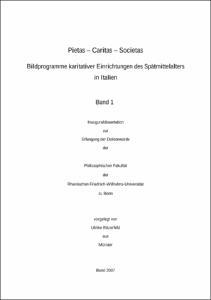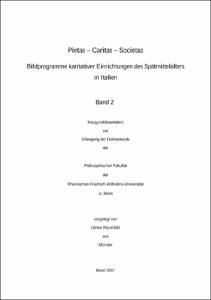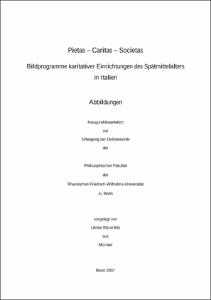Pietas - Caritas - SocietasBildprogramme karitativer Einrichtungen des Spätmittelalters in Italien

Pietas - Caritas - Societas
Bildprogramme karitativer Einrichtungen des Spätmittelalters in Italien

| dc.contributor.advisor | Schellewald, Barbara | |
| dc.contributor.author | Ritzerfeld, Ulrike | |
| dc.date.accessioned | 2020-04-09T09:52:48Z | |
| dc.date.available | 2020-04-09T09:52:48Z | |
| dc.date.issued | 2007 | |
| dc.identifier.uri | https://hdl.handle.net/20.500.11811/2757 | |
| dc.description.abstract | In der gesellschaftlichen Umbruchsphase des späten Mittelalters äußerte sich das Streben der Laienbevölkerung nach einer aktiven Rolle insbesondere auf dem Gebiet der Wohlfahrt. Diese fand vor allem im Rahmen der äußerst populären religiösen Bruderschaften und vergleichbaren Semireligiosengruppen statt, die gleichsam als Brennpunkte laikalen Aktionswillens auf der Suche nach eigenen religiöse Lebensformen, Heilswegen und politischen Rechten fungierten. Im Zentrum der Dissertation stehen die visuellen Ausdrucksformen dieser für die Stärkung der laikalen Position und die Entwicklung der Wohltätigkeit so folgenreichen Bewegung in Italien. Gerade die Bildkunst der Gemeinschaften läßt die speziellen Bedürfnisse und Anliegen wie auch die sich wandelnde gesellschaftliche Position der Laien hervortreten, wie an ausgesuchten Bildprogrammen karitativer Einrichtungen aus Bergamo, Florenz, Ancona, Prato, Assisi, Siena, Parma und Rom aus der Zeit zwischen 1300 und 1500 aufgezeigt werden kann. Pietas und Caritas, Frömmigkeit und Barmherzigkeit zu Gunsten des Hilfsbedürftigen wie auch des Wohltäters im Diesseits und im Jenseits bildeten das duale Leitprinzip der Sozietäten. Das Miteinander von religiöser und sozialer Zielsetzung prägte zugleich die per se sehr unterschiedlichen architektonischen Kulissen der korporativen Tätigkeit, resultierte in der Untrennbarkeit von religiöser und profaner Sphäre, von Kirchen, Kapellen und Oratorien mit Räumen der Vereinigungen und der Armen- und Krankenpflege. Auch deren Bilddekoration bestätigte mit ihrer Themenwahl die Bedeutung beider Aspekte, wie die in der vorliegenden Arbeit exemplarisch betrachtete Bildformel der biblischen „Werke der Barmherzigkeit“ beweist, diente doch die Matthäus-Perikope vom Weltgericht (Mt 25,31-46) als Leitmotiv der korporativen Fürsorge. In dem entsprechend häufig anzutreffenden ikonographischen Muster konnte eine summarische Darbietung theologischen Lehrguts in biblischer Form mit der sozial-historischen urbanen Realität und der Repräsentation der Auftraggeber verbunden werden. Mit der Visualisierung der gelebten Frömmigkeit wurde nicht nur der Laie an sich als Teil der Gemeinschaft bildwürdig, sondern seine in Wohltätigkeit transformierte, seinen Mitbürgern zugute kommende Religiosität wurde zum eigentlichen Bildthema: Der barmherzige Laie erhielt – im Bild wie im Leben – einen eigenen Standort im religiösen Heilsplan und in der spätmittelalterlichen Gesellschaftsordnung. Über das einzelne Mitglied hinaus erstreckte sich die heilsame Wirkung für Körper und Seele, welche der Bilddekor den Räumlichkeiten und der korporativen Tätigkeit zusprach, auf die Hilfesuchenden, ja auf die ganze Stadt. Das in Architektur wie Bild bezeichnende Ineinandergreifen von urbanem und korporativem Bereich macht die Stellung der Institutionen als sozial, wirtschaftlich und politisch wichtigen Bestandteil des städtischen Gefüges zwischen weltlichen und religiösen Mächten, ob Potentaten, kommunalen Regierungen, politischen Parteien, Bischöfen, Pfarreien oder Orden deutlich. Von diesen teils gänzlich instrumentalisiert, wurde der Bilddekor der Einrichtungen gezielt zur Propagierung spezieller Personen und Regierungen oder zur Verbreitung spezifischer religiöser Konzepte und Kultformen genutzt. In Sprache, Inhalt und Einsatz der Bilder zeigt sich die beträchtliche Transferleistung der Vereinigungen im Austausch religiöser und gesellschaftlicher Ideen, Normen, Rituale und Interessen, ihre maßgebende Funktion als Schaltstelle zwischen öffentlichem und privatem, politischem und religiösem, diesseitigem und jenseitigem Leben. | en |
| dc.description.abstract | Pietas - Caritas - Societas : Pictorial programs of charitable institutions in late medieval Italy In the social upheaval of the late middle ages, the striving of the lay population for an active role expressed itself especially in the area of charity. This was carried out in the main by the highly popular religious confraternities and similar groups, which at the same time acted as foci for the lay desire for their own forms of religious living, their own routes to salvation and their political rights. At the centre of the dissertation are the visual forms of expression of this movement in Italy, a movement which was to be so influential in the development of charity and in the strengthening of the lay position. The decorative art of local communities in particular allowed the specific desires and concerns of the lay population to be expressed, as well as illustrating their changing position in society as a whole. This can be seen in selected pictorial works from charitable establishments in Florence, Ancona, Prato, Assisi, Siena, Parma and Rome from the period between 1300 and 1500. Pietas and caritas, piety and mercy to help the needy as well as the charitable in this world and the one to come, formed the dual founding principle of the societies. At the same time, the coincidence of religious and social goals formed the per se divergent architectural backdrops of corporate activity. This resulted in the inseparability of the religious and the profane spheres, joining churches, chapels and oratories with the associations' halls and places for helping the poor or sick. In their choice of subjects, their pictorial decoration, too, confirmed the importance of both aspects, as is shown in the dissertation using the example of the formula pictures of the biblical “works of mercy”, where the Matthew pericope (Mt 25.31-46) of the Last Judgement is used as a leitmotiv for corporate charity. In the often-seen iconographic pattern, a summary presentation of theological teachings in biblical form is connected with social-historical reality, as well as with a representation of the sponsor. With the visualisation of lived devoutness, the lay person as part of the community became not only worthy of picturing, but his religiosity, transformed into charity and helping his fellows, became the actual subject of the picture. The charitable lay person received – in the picture as in life – his own place in the religious journey to salvation and in the late medieval social order. The healing effect for body and soul to which the pictorial decoration and corporate activity spoke, extended beyond the individual member, out to those seeking charity, and indeed to the whole city. The intertwining of urban and corporate spheres which was expressed in architecture as well as image makes clear the position of the institutions as an important social, economic, and political part of the urban structure – amongst the worldly and religious powers, the potentates, communal governments, political parties, bishops, parishes and religious orders. In part entirely instrumentalised by their patrons, the pictorial decorations of these institutions were purposefully used for the promotion of specific people and authorities, or for the dissemination of specific religious concepts and cults. The language, content and use of the pictures demonstrate the impressive achievements of the associations in their exchange of religious and social ideas, norms, rituals and interests, their defining function as interface between the public and the private, between the political and the religious, and between life in this world and in the next. | en |
| dc.language.iso | deu | |
| dc.rights | In Copyright | |
| dc.rights.uri | http://rightsstatements.org/vocab/InC/1.0/ | |
| dc.subject | Bruderschaft | |
| dc.subject | Fürsorge | |
| dc.subject | Laienseelsorge | |
| dc.subject | Frömmigkeit | |
| dc.subject | Hospital | |
| dc.subject | Baudekoration | |
| dc.subject | Fürsorge (Motiv) | |
| dc.subject | Ikonographie | |
| dc.subject | Werke der Barmherzigkeit | |
| dc.subject | Heilsweg | |
| dc.subject | Erlösung | |
| dc.subject | Laie | |
| dc.subject | Bergamo | |
| dc.subject | Consorzio della Misericordia | |
| dc.subject | Florenz | |
| dc.subject | Loggia del Bigallo | |
| dc.subject | Compagnia di S. Maria della Misericordia | |
| dc.subject | Oratorio dei Buonomini di S. Martino | |
| dc.subject | Siena | |
| dc.subject | Santa Maria della Scala | |
| dc.subject | Rom | |
| dc.subject | Ospedale di Santo Spirito | |
| dc.subject | Prato | |
| dc.subject | Palazzo Datini | |
| dc.subject | Ceppo Nuovo | |
| dc.subject | Parma | |
| dc.subject | Consorzio dei Vivi e dei Morti | |
| dc.subject | Baptisterium | |
| dc.subject | confraternity | |
| dc.subject | charity | |
| dc.subject | piety | |
| dc.subject | hospital | |
| dc.subject | decoration | |
| dc.subject | works of mercy | |
| dc.subject | salvation | |
| dc.subject | laity | |
| dc.subject.ddc | 700 Künste, Bildende Kunst allgemein | |
| dc.subject.ddc | 750 Malerei | |
| dc.title | Pietas - Caritas - Societas | |
| dc.title.alternative | Bildprogramme karitativer Einrichtungen des Spätmittelalters in Italien | |
| dc.type | Dissertation oder Habilitation | |
| dc.publisher.name | Universitäts- und Landesbibliothek Bonn | |
| dc.publisher.location | Bonn | |
| dc.rights.accessRights | openAccess | |
| dc.identifier.urn | https://nbn-resolving.org/urn:nbn:de:hbz:5-10836 | |
| ulbbn.pubtype | Erstveröffentlichung | |
| ulbbnediss.affiliation.name | Rheinische Friedrich-Wilhelms-Universität Bonn | |
| ulbbnediss.affiliation.location | Bonn | |
| ulbbnediss.thesis.level | Dissertation | |
| ulbbnediss.dissID | 1083 | |
| ulbbnediss.date.accepted | 19.06.2006 | |
| ulbbnediss.fakultaet | Philosophische Fakultät | |
| dc.contributor.coReferee | Bonnet, Anne-Marie |
Files in this item
This item appears in the following Collection(s)
-
E-Dissertationen (689)






